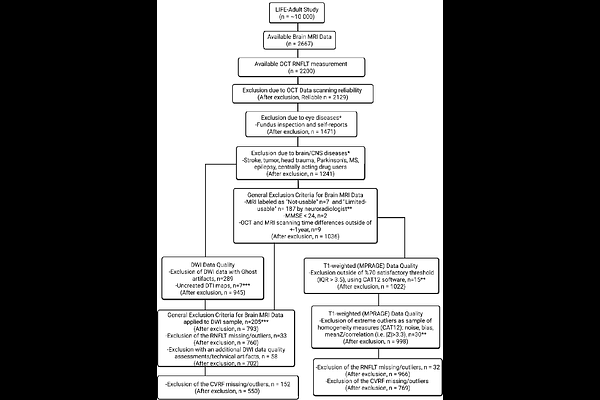Retinal nerve fibre layer thickness reflects characteristics of brain grey and white matter

Retinal nerve fibre layer thickness reflects characteristics of brain grey and white matter
Ayyildiz, N.; Mueller, K.; Hardikar, S.; Beyer, F.; Enzenbach, C.; Baber, R.; Wirkner, K.; Zachariae, S.; Girbardt, J.; Hassett, J. D.; Anwander, A.; Elze, T.; Wang, M.; Witte, A. V.; Rauscher, F. G.; Villringer, A.
AbstractThe retina is a relatively accessible part of the central nervous system compared to the brain. Using high resolution optical imaging we investigated the relationship between retinal thickness, obtained with optical coherence tomography, and structural features of the brain obtained with magnetic resonance imaging. In a population-based sample of over 500 subjects, we hypothesized: (i) that there are structural associations between circumpapillary retinal nerve fibre layer thickness and brain grey matter density and white matter microstructural properties in visual information processing areas, and specifically contralateral associations for nasal retinal fibers, and (ii) that retinal findings reflect broader changes in brain grey and white matter related to cardiovascular risk factors. In support of the first hypothesis, we showed associations of circumpapillary retinal nerve fibre layer thickness with visual cortex grey matter density and with optic radiation fractional anisotropy. These correlations were stronger for the right eye, possibly reflecting right ocular dominancy. Regarding the second hypothesis, while we confirmed the broad impact of cardiovascular risk factors such as body mass index, diabetes, and hypertension on brain structure, we didn\'t find (adequate) significant partial correlations between circumpapillary retinal nerve fibre layer thickness and cardiovascular risk factors to support the hypothesis. As such, we couldn\'t confirm that circumpapillary retinal nerve fibre layer thickness is associated with the impact of cardiovascular risk factors on the brain structure. However, when the effects of cardiovascular risk factors were accounted for statistically, circumpapillary retinal nerve fibre layer thickness (particularly on the right side) was associated with fractional anisotropy of limbic system tracts, i.e., the fornix and stria terminalis including hippocampus and amygdala. To further explore the structural associations between eye and brain, in terms of a possible common underlying pathology related to cardiovascular risk factors and progressive neurodegenerative diseases on the central nervous system, longitudinal and interventional studies are necessary.